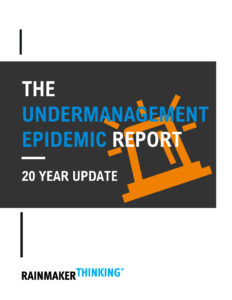Blog
What Is Undermanagement Costing You?
I’ve said it before: undermanagement can be difficult to identify. And yet, it is the number one cause of the most common preventable problems in the workplace. How is undermanagement going unnoticed?
There are two factors at play here: managing people is getting harder, and there are seven key areas of management with which leaders are struggling. Too many leaders today are failing to provide the guidance, structure, and support that their teams need to succeed. Most managers believe they are held back from being strong, highly-engaged leaders by some factor outside of their direct control. I call these the seven management myths.
But I simply don’t have enough time!
Probably the most common complaint I hear from managers and supervisors in my work is that they simply don’t have enough time to manage on top of all the other work for which they are responsible. But the irony is that, in the long run, undermanagement costs managers more in time and effort than simply managing in the first place.
In fact, there are eight costs that can be traced back to undermanagement. If these are recurring issues in your organization, despite your best efforts to fix them, it’s time to consider undermanagement as a possible cause.
1. Unnecessary problems occur, too often
Perhaps there’s an employee with a recurring performance issue that they can’t seem to fix. Or maybe a team is often involved in many, many rounds of drafts and revisions, even with the smallest assignments. It can be easy to blame the employee or employees in question in this case. But these recurring problems may be the result of a manager who is failing to sufficiently spell out expectations at the outset of an assignment, or effectively delegate a new task to someone.
2. Small, manageable problems escalate into bigger, less manageable problems
In this case, the manager is either not engaged enough in the team’s ongoing work to identify small problems early, or, they are afraid to address small problems, usually for fear of micromanaging. But when small problems are allowed to fly under the radar, they become bigger problems later on in the process. By then, it’s already too late, and the team has to be pulled into firefighting mode for a while.
3. Resources are squandered
Somewhere along the way, resources were either not adequately planned for, or a gap in communication resulted in wasted resources for one reason or another. In either case, it’s the manager’s responsibility to ensure that waste is minimized by clearly spelling out expectations, requirements, next steps, goals, and deadlines at the outset and every step of the way.
4. People go in the wrong direction on tasks, responsibilities, and projects
Simply put, if the manager is not engaged in regular, ongoing, one-on-one dialogue with every single employee they are responsible for, that manager is not going to be able to effectively course-correct. How is anyone supposed to know they are performing a task incorrectly if no one tells them?
5. Lower performers manage to hold on to their jobs longer
Likely the most pernicious cost of undermanagement is low performers going undetected by an unengaged manager. These employees cost you in terms of quality and productivity, all while collecting a paycheck. It’s not that you necessarily have to fire them either – it could just be that with a more highly-engaged manager, these employees would radically improve in a relatively short amount of time.
6. Mediocre performers are more likely to mistake themselves for high performers
It’s easy for managers to say, “So what? Let people think what they want about their performance.” But this is ultimately an issue of morale. If mediocre performers start to think they are high performers, two things will happen:
- Mediocre performers will start to wonder why they aren’t being given the same rewards and recognition as the real high performers, and…
7. High performers are more likely to think about leaving, or actually turn over
High performers want their results to be recognized for what they are. That usually means some kind of reward in line with that performance, whether the reward is tangible or intangible. But managers can never effectively reward employees in this way if they are not clearly spelling out the standards of high performance or keeping track of performance every step of the way.
8. Managers have a harder time delegating tasks to their direct reports
In this case, either the manager is responsible for a task that they feel cannot be delegated to someone else, or because they haven’t delegated effectively to begin with. When managers practice the basics of high-structure, high-substance communication with direct reports, and ask the right questions, they are usually much better at delegating effectively.
DOWNLOAD THE NEW UNDERMANAGEMENT EPIDEMIC REPORT
